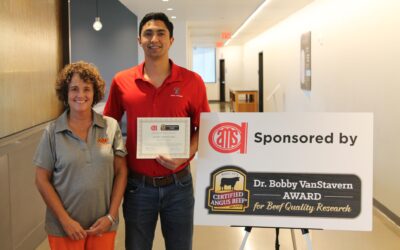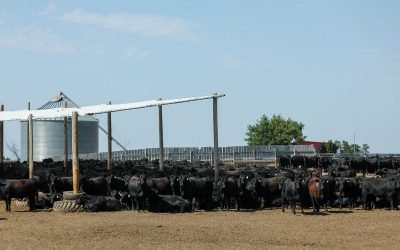
From research to real life
Scientists and technicians help cattlemen improve
by Miranda Reiman
Modified-live vaccines. The flat iron steak. Timed breeding protocols. Without beef researchers, farmers and ranchers across the country wouldn’t have all the products and applied technology that help them manage better. Consumers wouldn’t benefit from the rising beef quality they’ve enjoyed during the last decade.
Without people like Bridget Wasser, Larry Kuehn and Jon Schreffler the best answers might go unshared. These are the ones who not only do the research, but also help apply it.
Wasser, executive director of meat science at the National Cattlemen’s Beef Association, does more than 40 cutting demonstrations a year. As a contractor to the beef checkoff, she’ll present about innovative fabrication to a group of regional meat cutters one day and will talk about USDA quality grades to international trade partners the next.
“Travel is where you see your work come to life. It’s a very rewarding part of my job,” Wasser says.
Ahead of time, she learns about her audience and makes certain she has all the right tools (including a table, cutting boards and, of course, the beef).
Days in the office take on a different tone. Wasser could be talking with meat researchers about their latest ideas for tenderness or beef flavor studies. She checks in on the progress of such projects already in the works, or she figures out ways to get the latest information out so all that meat science “doesn’t just sit on a shelf.”
“We’re trying to improve the quality of beef and the overall quality of the eating experience to our customers,” Wasser says. At Texas A&M University, she worked on projects funded by the checkoff. Nearly 10 years since coming to the other side of the process, she still appreciates the chance to be a research enabler.
Wasser knows it’s making a difference for cattlemen and beef eaters across the U.S. In a 2013 survey, 72% of consumers listed beef as their top choice of proteins.

To keep and grow that position, Wasser fields questions daily. When she gets one about beef quality or variability, she thinks about the answers left to uncover.
Those same questions keep Larry Kuehn motivated by his work as a geneticist at the U.S. Meat Animal Research Center, part of the USDA Agricultural Research Service.
His job is not only to complete complex projects, but then to make things like haplotypic relationships and single-nucleotide polymorphisms understandable to the cattlemen who will benefit from that knowledge.
At Clay Center, Neb., Kuehn works just 40 miles from the diversified farm he grew up on, where raking hay and processing calves not only shaped his career path, they almost were his career path. A timely crash in the cattle market encouraged him to seek further education beyond and Kuehn now enjoys dividing time between analyzing data, and being outside to take weaning notes or make phenotypic observations, for example.
For the last eight years, he has joined colleagues Mark Thallman and Warren Snelling continuing to work on the Germplasm Evaluation Program started decades ago.
“Today we’re trying to stay current,” Kuehn says of the annual samplings of the most popular breeds and bulls within those breeds.
He looks ahead to exciting possibilities, like a DNA test that could predict disease resistance or individual animal management based on specific genetic makeup, but is still very interested in the application of what he sees now.
“Breeds generally try to race each other toward the same goals rather than rely on their strengths,” Kuehn says, noting that the maximum growth doesn’t always equal the maximum profit.

He knows data is virtually useless unless producers use it, so he enjoys the outreach.
“It’s a good test if you can explain the process,” he says. “It’s a fun puzzle.”
But behind every researcher like Kuehn is at least one reliable soul who personally takes ownership in making the research designs come to life.
That’s what reproductive physiologist Dave Patterson, of the University of Missouri, says he has in Jon Schreffler, who worked his way up from part-time help after school to farm manager at Thompson Research Center.
Many of the influential artificial insemination (AI) and timed breeding protocol studies have come from work Patterson and his team completed at that Spickard, Mo., farm.
“I started at the bottom of the ladder and experienced every wrung on the way up,” says Schreffler, who now manages the 240-cow herd.
“We started with crossbred cows, a mixture of everything, leftovers of the heterosis studies of the late ’60s,” he says. Now they’re primarily Angus because the breed represents the North-central Missouri area well and helped the herd develop a consistent base for research.
“The improvements seen in 15 years and the data that proves it, that’s just amazing,” Schreffler says. “We have functional cows because we focus on maternal along with carcass traits, and the bulls we use are highly proven, and that made a big difference on both sides.”
The last five years have seen Certified Angus Beef ® (CAB®) brand and Prime rates from 85% to 90%.
“Now we’re working on culling the bottom end and adding more growth and performance without giving up the quality,” Schreffler says. “There’s lots of dollars in efficiency and getting more pounds, especially when they’re premium pounds.”
Helping producers profitably produce more – and better – beef: that’s the mission to which so many on the research side, like Schreffler, Kuehn and Wasser, dedicate their careers.
You may also like
Certified Angus Beef Recognizes Beef Quality Research
First-place honors go to Andres Mendizabal, an international student pursuing a Ph.D. in animal science at Texas Tech University. His research is titled, “The Accuracy of USDA Yield Grade and Beef Carcass Components as Predictors of Red Meat Yield.”
Not all good days are sunny and warm
Stress of any kind affects performance and health, but also well-being and behavior, a special focus for CSU animal scientist Lily Edwards-Callaway. Her team’s literature review found shade benefits vary by location, structure type and the weather.
Flavor’s secret ingredient
As a moderately to highly heritable trait, marbling is something that cattlemen have a lot of ability to manage. It also happens to be one of the major contributors to beef flavor. Texas Tech University meat scientist Jerrad Legako spoke about the topic at the 2020 American Society of Animal Science meetings.



